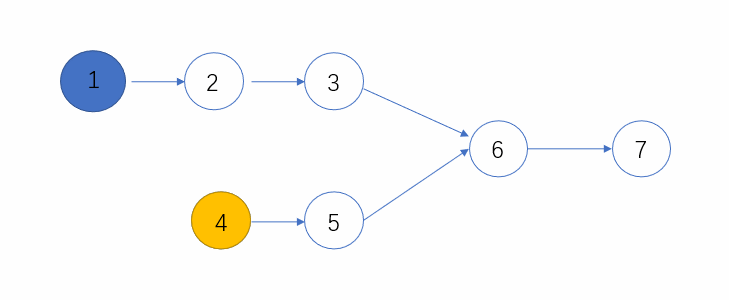题目描述:
输入两个无环的单向链表,找出它们的第一个公共结点,如果没有公共节点则返回空。(注意因为传入数据是链表,所以错误测试数据的提示是用其他方式显示的,保证传入数据是正确的)
数据范围: n<=1000
要求:空间复杂度 O(1),时间复杂度 O(n)
例如,输入{1,2,3},{4,5},{6,7}时,两个无环的单向链表的结构如下图所示:

可以看到它们的第一个公共结点的结点值为6,所以返回结点值为6的结点。
输入描述:
输入分为是3段,第一段是第一个链表的非公共部分,第二段是第二个链表的非公共部分,第三段是第一个链表和二个链表的公共部分。 后台会将这3个参数组装为两个链表,并将这两个链表对应的头节点传入到函数FindFirstCommonNode里面,用户得到的输入只有pHead1和pHead2。
返回值描述:
返回传入的pHead1和pHead2的第一个公共结点,后台会打印以该节点为头节点的链表。
示例:
输入:
{1,2,3},{4,5},{6,7}
返回值:
{6,7}
说明:
第一个参数{1,2,3}代表是第一个链表非公共部分,第二个参数{4,5}代表是第二个链表非公共部分,最后的{6,7}表示的是2个链表的公共部分
这3个参数最后在后台会组装成为2个两个无环的单链表,且是有公共节点的
解题思路:
本题考察数据结构链表的使用。将两个链表指针向前步进,走到头后就错位继续前进,因为两个指针行进的速度一致,走着走着就撞一起了,如下方gif动画所示,很直观。

测试代码:
/*
struct ListNode {
int val;
struct ListNode *next;
ListNode(int x) :
val(x), next(NULL) {
}
};*/
class Solution {
public:
ListNode* FindFirstCommonNode( ListNode* pHead1, ListNode* pHead2) {
ListNode *a=pHead1,*b=pHead2;
while(a!=b)
{
a=a?a->next:pHead2;
b=b?b->next:pHead1;
}
return a;
}
};
补充
通过C++找出两个链表的所有公共结点:
// FindFirstCommandNode.cpp : 定义控制台应用程序的入口点。
//
#include "stdafx.h"
#include <iostream>
using namespace std;
struct ListNode
{
int m_nKey;
ListNode* m_pNext;
ListNode(int i):m_nKey(i)
{
}
};
//获取链表长度
int GetListLength(ListNode* pHead)
{
int nLength = 0;
ListNode* pNode = pHead;
while (pNode != NULL)
{
++nLength;
pNode = pNode->m_pNext;
}
return nLength;
}
ListNode* FindFirstCommandNode(ListNode* pHead1, ListNode* pHead2)
{
int nLength1 = GetListLength(pHead1);
int nLength2 = GetListLength(pHead2);
int nLengthDif = 0;//两个链表的长度差
ListNode* pListHeadLong = NULL;//用于指向长链表
ListNode* pListHeadShort = NULL;//用于指向短链表
//根据长度判断 链表指向
if (nLength1 > nLength2)
{
nLengthDif = nLength1 - nLength2;
pListHeadShort = pHead2;
pListHeadLong = pHead1;
}
else
{
nLengthDif = nLength2 - nLength1;
pListHeadLong = pHead2;
pListHeadShort = pHead1;
}
//先对长链表进行移动 移动到与短链表长度相同的位置
for (int i = 0; i < nLengthDif; i++)
{
pListHeadLong = pListHeadLong->m_pNext;
}
//寻找公共节点
while (pListHeadLong !=NULL && pListHeadShort != NULL && pListHeadLong!= pListHeadShort)
{
pListHeadLong = pListHeadLong->m_pNext;
pListHeadShort = pListHeadShort->m_pNext;
}
//如果不为空 此时的pListHeadLong 与pListNodeShort为同一个节点,返回该节点
if (pListHeadLong != NULL)
{
return pListHeadLong;
}
else
{
return NULL;//否则返回NULL
}
}
int _tmain(int argc, _TCHAR* argv[])
{
ListNode* head1 = new ListNode(0);
ListNode* head2 = new ListNode(1);
ListNode* node0 = new ListNode(22);
ListNode* node1 = new ListNode(2);
ListNode* node2 = new ListNode(3);
ListNode* node3 = new ListNode(4);
ListNode* node4 = new ListNode(5);
ListNode* node5 = new ListNode(6);
ListNode* node6 = new ListNode(7);
ListNode* node8 = new ListNode(6);
head1->m_pNext = node1;
node1->m_pNext = node0;
node0->m_pNext = node3;
node3->m_pNext = node5;
node5->m_pNext = node6;
node6->m_pNext = NULL;
head2->m_pNext = node2;
node2->m_pNext = node4;
node4->m_pNext = node8;
node8->m_pNext = node6;
node6->m_pNext = NULL;
cout<<"链表1的长度为:"<<GetListLength(head1)<<endl;
cout<<"链表2的长度为:"<<GetListLength(head2)<<endl;
ListNode* CommNode = FindFirstCommandNode(head1,head2);
if (CommNode!= NULL)
{
cout<<"公共节点的值为:"<<CommNode->m_nKey<<endl;
}
else
{
cout<<"没有公共节点"<<endl;
}
getchar();
return 0;
}
到此这篇关于C++ 解决求两个链表的第一个公共结点问题的文章就介绍到这了,更多相关C++ 求两个链表的公共结点内容请搜索服务器之家以前的文章或继续浏览下面的相关文章希望大家以后多多支持服务器之家!
原文链接:https://blog.csdn.net/zhaitianbao/article/details/121769106
















